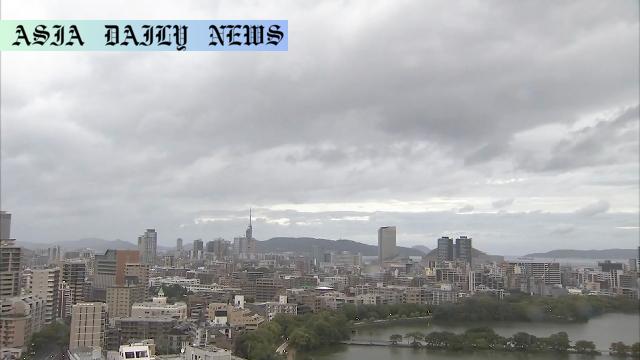Unstable Weather: Japanese Weather Agency Alerts Residents to High Temperatures and Heavy Rainfall in Western Japan
- Unstable atmospheric conditions with heavy rain expected in western Japan.
- Caution advised for mudslides, flooding, and heat-related risks.
- High temperatures forecasted with heatstroke alerts in multiple regions.

Unstable Atmospheric Conditions Threaten Western Japan
Unstable weather continues to affect large parts of western Japan, as forecasted by the Japan Meteorological Agency. A low-pressure system, accompanied by a rain front, is expected to traverse the region from Monday, bringing localized heavy rainfall, particularly in northern Kyushu. The agency has warned of downpours exceeding 30 millimeters per hour in some areas through Tuesday morning and a possible accumulation of up to 100 millimeters over 24 hours in affected regions. These hazardous conditions elevate the risk of mudslides, flooding in low-lying areas, and swollen rivers, potentially causing widespread disruption.
Precautions Against Storms and Thunderclouds
Weather officials have specifically urged residents to remain vigilant against severe localized weather phenomena, including thunderstorms, lightning strikes, and the possibility of tornadoes. As thunderclouds approach, individuals are advised to seek immediate shelter inside sturdy buildings to safeguard themselves from potential harm. The sudden and unpredictable nature of these events highlights the importance of constant weather monitoring and community preparedness during the forecasted period of instability.
Heatwave Conditions Raise Public Health Concerns
Adding to the weather challenges, temperatures are expected to soar in western to eastern Japan on Monday, with daytime highs predicted to reach 36 degrees Celsius in Niihama City, Ehime Prefecture, and 35 degrees Celsius in cities like Takamatsu, Okayama, and Toyooka. Heatstroke alerts are in place for regions such as Wakayama and Kagawa Prefectures, as well as the Amami region of Kagoshima Prefecture and the Yaeyama region of Okinawa Prefecture. Public health authorities have emphasized the importance of taking preventative measures against heatstroke, advising the use of air conditioning, staying hydrated with water and electrolytes, and avoiding prolonged outdoor exposure during peak heat hours.
Addressing Extended Weather Challenges
The Meteorological Agency has noted that high temperatures are likely to persist throughout the week, further compounding public safety challenges. Residents are encouraged to remain alert and adhere to weather warnings issued by authorities. Prolonged exposure to such adverse conditions demands coordinated action and community support to minimize risks to health and infrastructure. Whether navigating the immediate threats of flooding and storms or addressing the prolonged effects of scorching heat, it is crucial for residents to prioritize safety and take necessary precautions.



Commentary
Understanding the Impacts of Unstable Weather Conditions
The unpredictable and often destructive nature of unstable weather patterns reminds us of the delicate balance within our planet’s ecosystem. In regions such as Japan, where geographic characteristics make certain areas more susceptible to natural phenomena, the importance of timely weather alerts cannot be overstated. Heavy rainfall, flash floods, and mudslides disrupt not only day-to-day life but often result in the loss of property and livelihoods. Authorities and individuals alike must work collaboratively to brace for and minimize the impact of these events.
The Dual Challenge: Heavy Rain and Rising Heat
Managing dual threats—localized heavy rain alongside soaring temperatures—is no easy feat. While the heavy downpours bring immediate risks such as flooding and infrastructure damage, the concurrent rise in temperature poses long-term implications for public health. Heatstroke alerts, already issued for various regions, reinforce the fact that extreme heat can be as dangerous as any natural disaster. Access to reliable cooling systems, hydration resources, and awareness programs for vulnerable populations like the elderly and children should become top priorities for communities facing these extreme conditions.
The Role of Preparedness and Education
Preparedness is key in mitigating the dangers posed by erratic weather. Local governments and weather agencies play an integral role in keeping residents informed and equipped to handle climatic challenges. However, individuals too must stay proactive—monitoring updates, heeding warnings, and taking precautions are small yet impactful steps to ensure safety. Education on recognizing heatstroke symptoms, understanding flood-risk zones, and accessing evacuation centers can prove life-saving during crises.
Final Thoughts: A Call for Resilience
As weather patterns grow increasingly unpredictable due to climate change, the need for resilience within communities becomes ever more urgent. Japan’s response to these ongoing weather challenges will undoubtedly serve as a learning model for other regions facing similar threats globally. By fostering a culture of preparedness and adaptability, together we can reduce the human and economic toll that unstable weather conditions might bring.